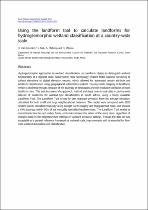 ResearchSpace
ResearchSpace
Using the landform tool to calculate landforms for hydrogeomorphic wetland classification at a country-wide scale
JavaScript is disabled for your browser. Some features of this site may not work without it.
- ResearchSpace
- →
- Research Publications/Outputs
- →
- Journal Articles
- →
- View Item
| dc.contributor.author |
Van Deventer, Heidi

|
|
| dc.contributor.author |
Nel, J

|
|
| dc.contributor.author |
Maherry, A

|
|
| dc.contributor.author |
Mbona, N

|
|
| dc.date.accessioned | 2015-03-12T10:05:53Z | |
| dc.date.available | 2015-03-12T10:05:53Z | |
| dc.date.issued | 2014-11 | |
| dc.identifier.citation | Van Deventer, H, Nel, J, Maherry, A and Mbona, N. 2014. Using the landform tool to calculate landforms for hydrogeomorphic wetland classification at a country-wide scale. South African Geographical Journal, DOI:10.1080/03736245.2014.977812 | en_US |
| dc.identifier.issn | 0373-6245 | |
| dc.identifier.uri | http://www.tandfonline.com/doi/pdf/10.1080/03736245.2014.977812 | |
| dc.identifier.uri | http://hdl.handle.net/10204/7934 | |
| dc.description | Copyright: 2014 Taylor& Francis.Due to copyright restrictions, the attached PDF file only contains the abstract of the full text item. For access to the full text item, please consult the publisher's website. | en_US |
| dc.description.abstract | Hydrogeomorphic approaches to wetland classification use landform classes to distinguish wetland functionality at a regional scale. Space-borne radar technology enabled faster regional surveying of surface elevations to digital elevation models, which allowed for automated terrain attribute and landform classification using geographical information systems. Country-wide mapping of landforms remain a challenge though, because of the diversity of landscapes and non-exclusive attributes of each landform class. This article presents the approach, method and steps taken to calculate a country-wide data-set of landforms for wetland-type classification in South Africa, using a freely available Landform Tool. The Landform Tool primarily uses standard deviation from the average elevation, calculated for both small and large neighbourhood distances. The results were compared with 2820 random points, classified manually using Google Earth imagery and topographical maps, and showed a 43% accuracy within 50m of the manually identified landform class. The Landform Tool tended to overestimate benches and valley floors, and underestimate the extent of the slope class, regardless of changes made in the neighbourhood settings or standard deviation settings. Though the data-set was acceptable as a general reference framework at national scale, improvements will be essential for fine-scale wetland delineation and classification. | en_US |
| dc.language.iso | en | en_US |
| dc.publisher | Taylor & Francis | en_US |
| dc.relation.ispartofseries | Workflow;14003 | |
| dc.subject | Landscape position | en_US |
| dc.subject | Landforms | en_US |
| dc.subject | Topographic position index | en_US |
| dc.subject | Topography tools | en_US |
| dc.subject | Geographical information systems | en_US |
| dc.subject | Wetland typing | en_US |
| dc.title | Using the landform tool to calculate landforms for hydrogeomorphic wetland classification at a country-wide scale | en_US |
| dc.type | Article | en_US |
| dc.identifier.apacitation | Van Deventer, H., Nel, J., Maherry, A., & Mbona, N. (2014). Using the landform tool to calculate landforms for hydrogeomorphic wetland classification at a country-wide scale. http://hdl.handle.net/10204/7934 | en_ZA |
| dc.identifier.chicagocitation | Van Deventer, Heidi, J Nel, A Maherry, and N Mbona "Using the landform tool to calculate landforms for hydrogeomorphic wetland classification at a country-wide scale." (2014) http://hdl.handle.net/10204/7934 | en_ZA |
| dc.identifier.vancouvercitation | Van Deventer H, Nel J, Maherry A, Mbona N. Using the landform tool to calculate landforms for hydrogeomorphic wetland classification at a country-wide scale. 2014; http://hdl.handle.net/10204/7934. | en_ZA |
| dc.identifier.ris | TY - Article AU - Van Deventer, Heidi AU - Nel, J AU - Maherry, A AU - Mbona, N AB - Hydrogeomorphic approaches to wetland classification use landform classes to distinguish wetland functionality at a regional scale. Space-borne radar technology enabled faster regional surveying of surface elevations to digital elevation models, which allowed for automated terrain attribute and landform classification using geographical information systems. Country-wide mapping of landforms remain a challenge though, because of the diversity of landscapes and non-exclusive attributes of each landform class. This article presents the approach, method and steps taken to calculate a country-wide data-set of landforms for wetland-type classification in South Africa, using a freely available Landform Tool. The Landform Tool primarily uses standard deviation from the average elevation, calculated for both small and large neighbourhood distances. The results were compared with 2820 random points, classified manually using Google Earth imagery and topographical maps, and showed a 43% accuracy within 50m of the manually identified landform class. The Landform Tool tended to overestimate benches and valley floors, and underestimate the extent of the slope class, regardless of changes made in the neighbourhood settings or standard deviation settings. Though the data-set was acceptable as a general reference framework at national scale, improvements will be essential for fine-scale wetland delineation and classification. DA - 2014-11 DB - ResearchSpace DP - CSIR KW - Landscape position KW - Landforms KW - Topographic position index KW - Topography tools KW - Geographical information systems KW - Wetland typing LK - https://researchspace.csir.co.za PY - 2014 SM - 0373-6245 T1 - Using the landform tool to calculate landforms for hydrogeomorphic wetland classification at a country-wide scale TI - Using the landform tool to calculate landforms for hydrogeomorphic wetland classification at a country-wide scale UR - http://hdl.handle.net/10204/7934 ER - | en_ZA |





